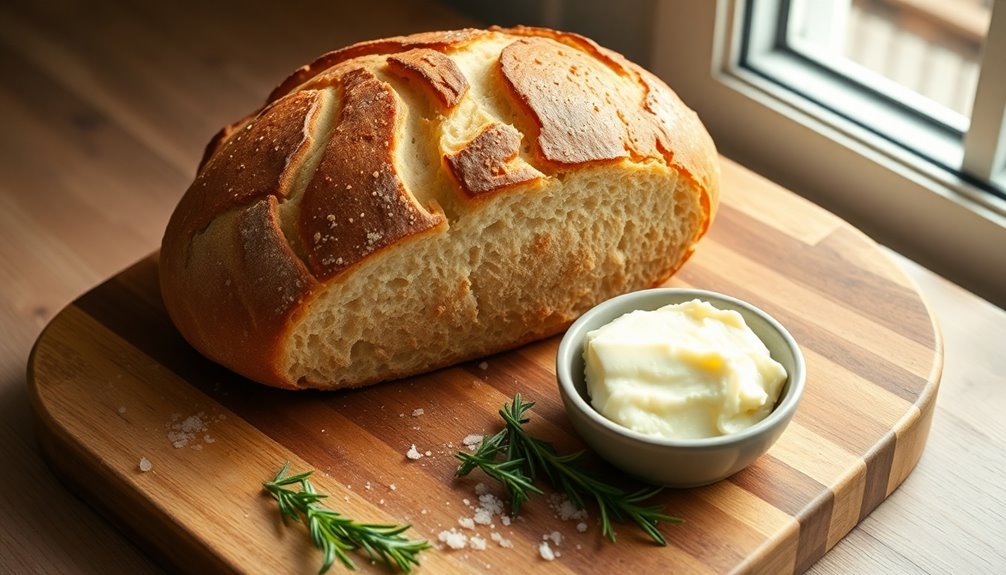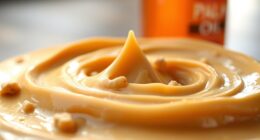Reimagining bread basics with sourdough brioche is a game changer. You combine the rich, buttery flavor of brioche with the tangy notes of sourdough for a healthier loaf. Start by building a levain and preparing a yudane mixture to boost moisture. Incorporate softened butter into your dough for that perfect texture. With the right proofing techniques and fermentation, you'll create a light, fluffy treat. Stick around to discover more tips and tricks for mastering this delicious bread.
Key Takeaways
- Sourdough brioche combines the rich flavor of brioche with the airy texture of sourdough, resulting in a unique and delightful loaf.
- Building a levain mixture is essential for flavor and texture, utilizing a 1:1:1 ratio of sourdough starter, water, and flour.
- The Yudane mixture adds moisture and improves the final texture, created by mixing equal parts flour and boiling water.
- Bulk fermentation at 78ºF enhances yeast activity and gluten development, crucial for achieving a fluffy crumb in brioche.
- Incorporating softened butter during mixing ensures even distribution and contributes to a moist, tender brioche loaf.
History
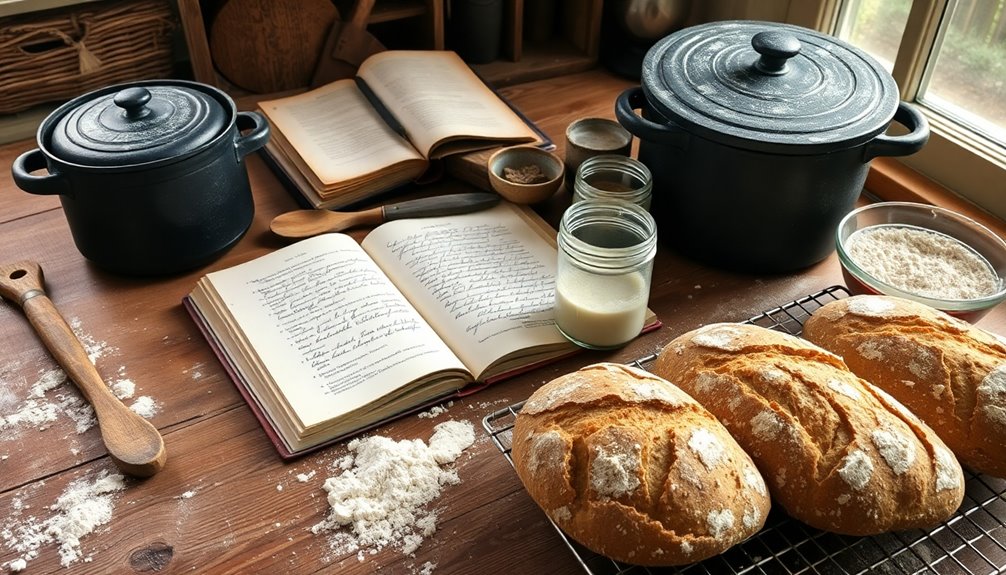
Brioche has a rich history that dates back to 15th century Normandy, France, where it was crafted as a luxurious bread for special occasions.
The term "brioche" comes from the Norman word "brier," meaning to knead, highlighting the labor-intensive process involved in making this enriched dough.
Originally, it was a delicacy enjoyed primarily by the upper classes, thanks to its lavish ingredients like eggs and butter, symbolizing wealth and abundance.
The introduction of commercial yeast in the 19th century transformed brioche baking, enabling quicker and more consistent fermentation than traditional sourdough methods.
Today, you've got a variety of brioche forms—from loaves to pastries—showcasing its versatility in both sweet and savory dishes, enriching the bread-making landscape.
Recipe
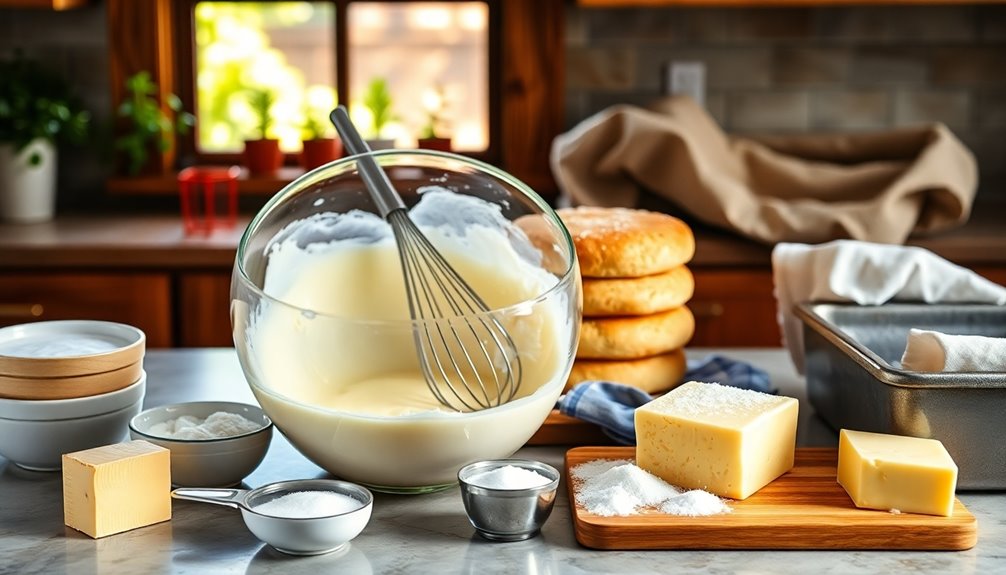
Sourdough brioche is a delightful twist on the classic brioche, infusing the rich, buttery flavor with the tangy notes from your active sourdough starter. This bread is perfect for breakfast, brunch, or as a sweet treat any time of day. The combination of high-quality ingredients and a carefully crafted process results in a light and fluffy texture with a tender crumb that will impress anyone fortunate enough to taste it.
To embark on this baking adventure, ensure you have a well-fed sourdough starter ready to go. The fermentation process is critical, as it helps develop the bread's flavor and structure. You'll need to dedicate some time for the dough to rise properly, but the results are well worth the wait. Understanding the importance of fermentation can significantly enhance your baking skills and outcomes.
Prepare to enjoy the aroma that fills your kitchen as this delightful sourdough brioche bakes to golden perfection.
Ingredients:
- 1 cup active sourdough starter
- 4 cups bread flour
- 1/4 cup sugar
- 1/2 cup milk, warmed
- 4 large eggs
- 1 cup unsalted butter, softened
- 1 teaspoon salt
Instructions:
In a large mixing bowl, combine the active sourdough starter, warm milk, sugar, and eggs, whisking until smooth. Gradually add the bread flour and salt, mixing until a shaggy dough forms.
Begin incorporating the softened butter a few tablespoons at a time, mixing well after each addition until fully incorporated. Once the butter is blended in, knead the dough for about 10 minutes until it becomes smooth and elastic.
Transfer the dough to a lightly greased bowl, cover it with plastic wrap or a damp cloth, and allow it to bulk ferment for 6-8 hours until it has doubled in size. For enhanced flavor, you can cold-proof the dough in the refrigerator overnight.
After the fermentation period, shape the dough into your desired form, place it into a greased loaf pan, and let it rise again for about 1-2 hours. Preheat your oven to 350°F and bake the brioche for approximately 45 minutes or until it's golden brown and fully cooked. Allow it to cool before slicing.
Extra Tips:
When making sourdough brioche, patience is key, especially during the fermentation stages. If you want a more complex flavor, consider using a mix of bread flour and all-purpose flour.
Additionally, be mindful of the temperature of your ingredients; using room temperature butter and eggs will help the dough come together more easily. To keep your brioche moist after baking, wrap it tightly in plastic wrap or store it in an airtight container at room temperature for up to five days, or freeze it for longer storage.
Enjoy your baking experience and the delicious results!
Cooking Steps
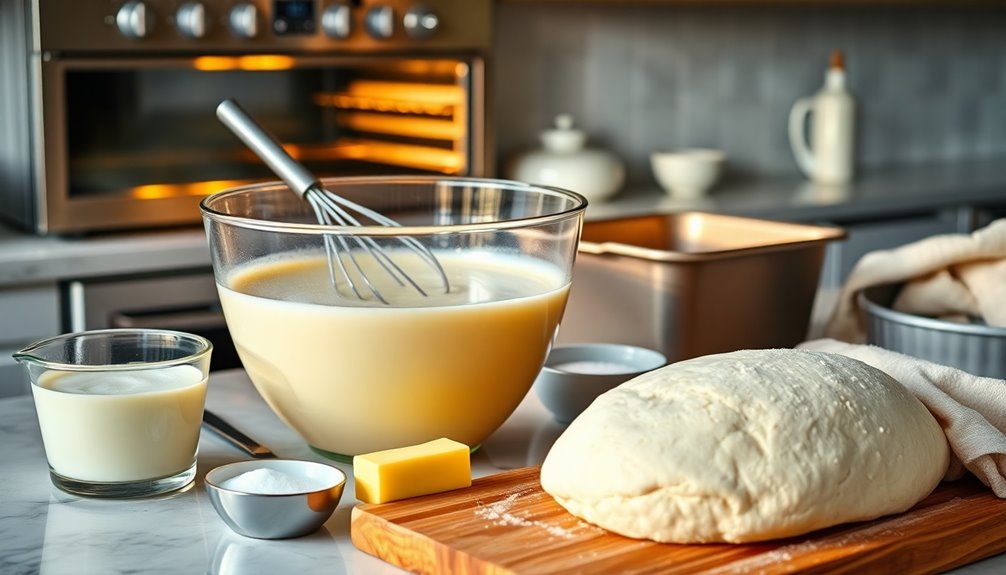
To get started, you'll want to build your levain mixture and prepare the yudane mixture for a flavorful base.
Once you've combined all the ingredients thoroughly, it's time to incorporate softened butter for that rich texture, which can enhance the dough's flavor and moisture due to its fat content.
After that, let your dough undergo bulk fermentation at 78ºF to develop its structure.
Step 1. Build the Levain Mixture
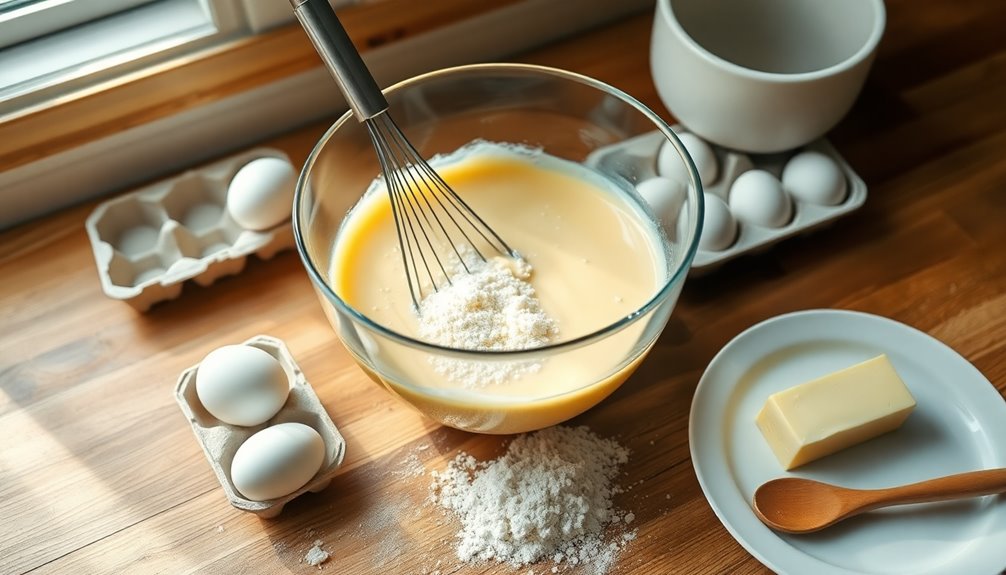
Before diving into the bread-making process, you'll want to create a robust levain mixture that serves as the backbone of your dough.
Start by weighing out about 30 grams of active sourdough starter using a baking scale for accuracy. Combine this starter with an equal weight of room temperature water to enhance fermentation.
Next, add in a specific amount of bread flour, following a common 1:1:1 ratio (starter:water:flour) for the best bubbly rise. Mix everything thoroughly until no dry spots remain, then cover the bowl with a cloth or plastic wrap to retain warmth and moisture.
Let the levain ferment at room temperature for several hours, or until it doubles in size and becomes bubbly, signaling it's ready for your brioche dough. This fermentation process is crucial, as it develops the buttery flavor and texture that make brioche so delightful, thanks to the fat content in butter.
Step 2. Prepare the Yudane Mixture
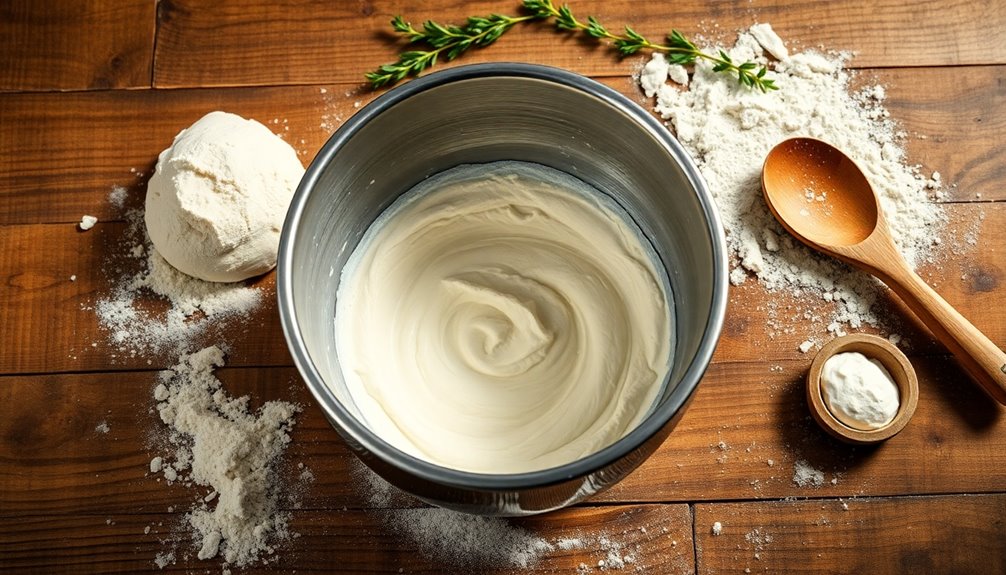
With your levain mixture ready and bubbling, it's time to prepare the Yudane mixture, which will add moisture and a delightful texture to your brioche.
Start by measuring equal parts of flour and boiling water, using a 1:1 ratio. Combine them in a bowl and stir until you achieve a smooth paste. This process gelatinizes the flour, enhancing moisture retention in your enriched doughs.
Let the Yudane cool to room temperature to avoid cooking any other ingredients, especially the eggs. If you want, you can prepare the Yudane in advance and refrigerate it for up to three days, as this will improve the flavor and texture of your final bread.
Now, you're ready for the next step!
Step 3. Combine Ingredients Thoroughly
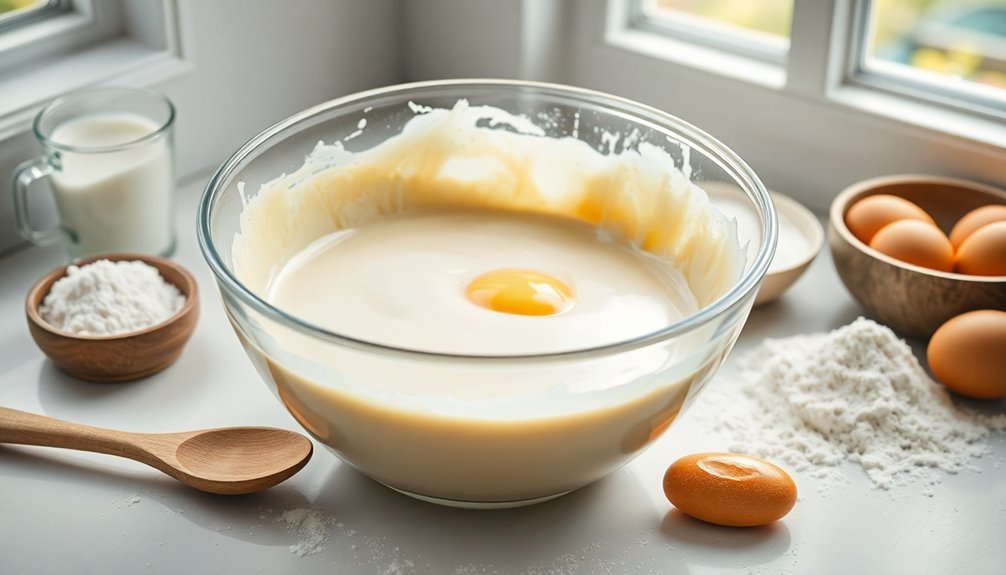
Start by combining your ripe sourdough starter, bread flour, sugar, and salt in a mixing bowl to form a shaggy dough.
Next, add room temperature whole milk and two large eggs, mixing until a rough dough forms.
Allow it to rest for about 30 minutes to hydrate, which helps develop the flavors in your brioche.
Use a stand mixer with a dough hook for effective gluten development, mixing on medium speed for at least 10 minutes until the dough passes the windowpane test.
It's crucial to ensure all ingredients are combined thoroughly to prevent lumps and achieve a consistent dough that will rise evenly during fermentation.
Understanding the importance of effective gluten development can significantly enhance the texture of your bread, leading to a more enjoyable eating experience.
This groundwork sets you up for a delicious bread experience!
Step 4. Incorporate Softened Butter
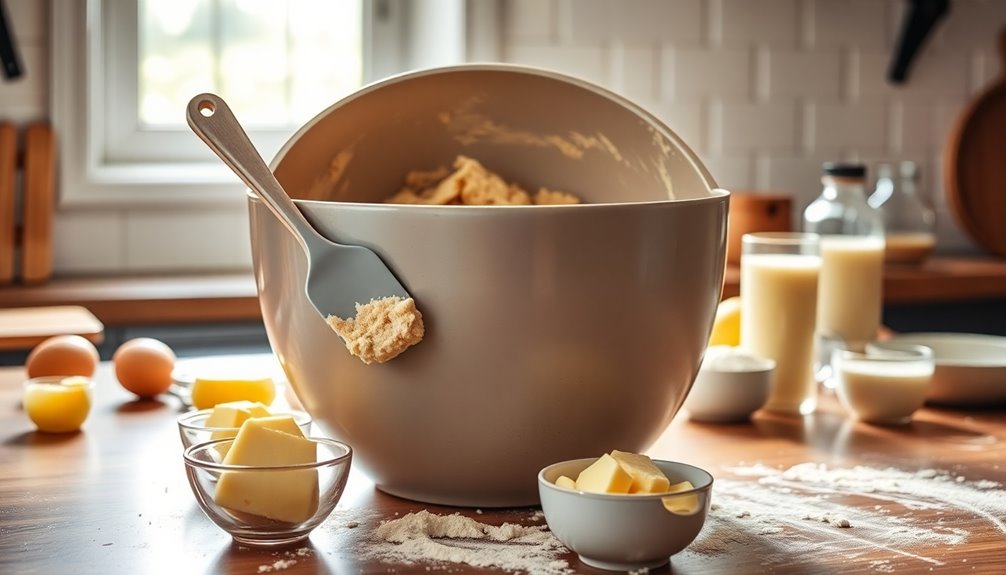
As you move forward in your brioche-making journey, incorporating softened butter is a key step that enhances both texture and flavor.
Begin by slicing room temperature unsalted butter into at least eight pieces. Add these pieces one at a time to your sourdough brioche dough while mixing on medium speed. This method ensures even distribution and promotes gluten development.
Mix for at least 10 minutes after adding the softened butter to fully develop the gluten, performing the windowpane test to check for elasticity. This technique maintains a moist dough consistency, crucial for achieving the light and fluffy texture characteristic of brioche. Additionally, using unsalted butter allows for better control over the salt content in your recipe.
Step 5. Bulk Fermentation at 78ºF
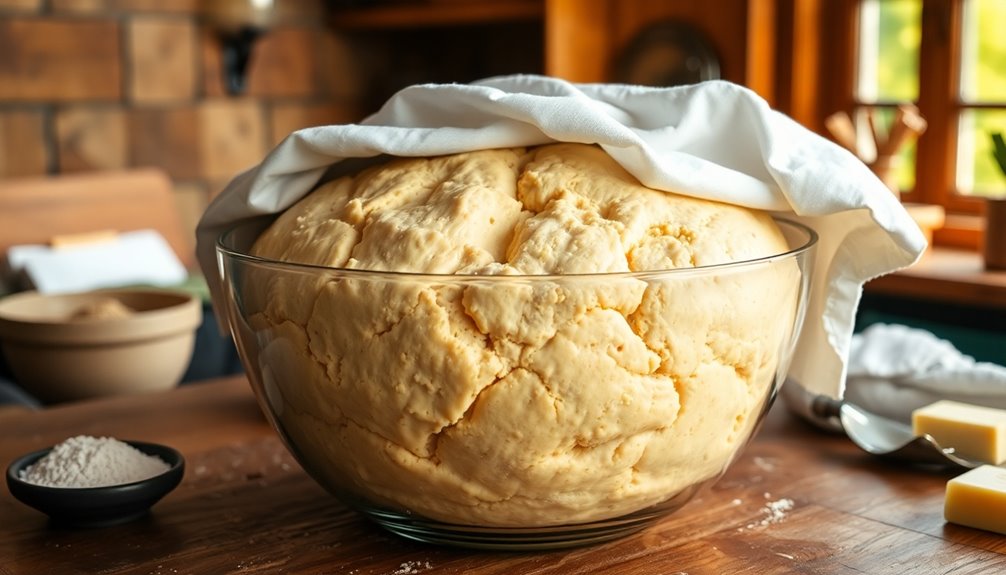
After incorporating that softened butter, your brioche dough is ready for bulk fermentation at 78ºF.
This warm room temperature promotes optimal yeast activity, essential for your sourdough brioche recipe. Cover the dough to prevent dehydration and allow it to rise until it nearly doubles in size, which should take about 6-8 hours.
During the first hour, perform stretch and folds to strengthen the gluten structure, making your brioche lighter and fluffier.
Keep an eye on the dough for bubbles and a smooth, elastic texture, as these signs indicate healthy fermentation.
If your kitchen feels cold, consider using a proofing box to maintain the ideal temperature for consistent results.
Happy baking!
Final Thoughts
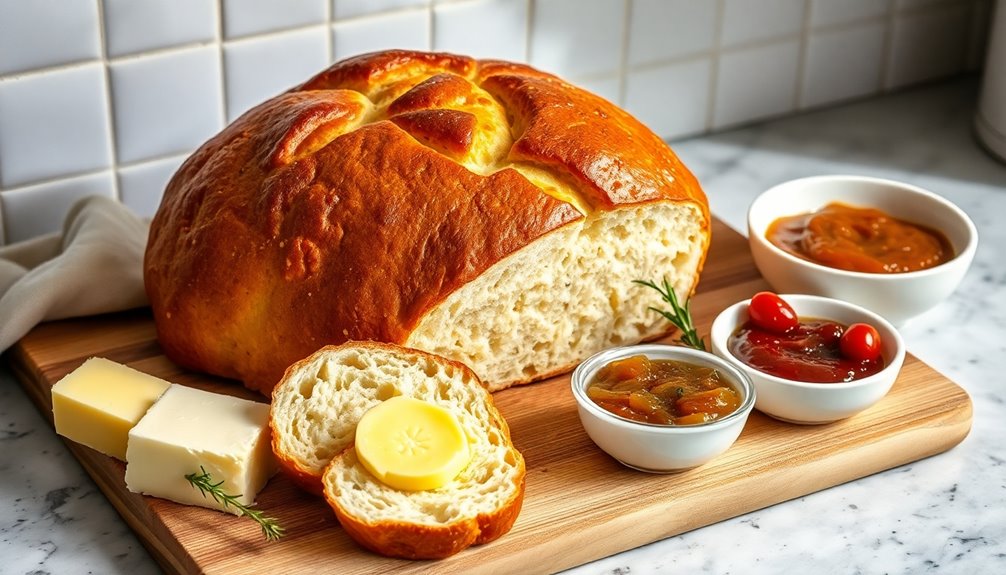
While mastering sourdough brioche might seem daunting at first, the rewards are undeniably worth the effort.
This enriched bread combines the rich, buttery flavor of traditional brioche with the airy texture that sourdough fermentation provides, resulting in a healthier loaf.
To achieve perfect sourdough brioche bread, ensure your starter is active and bubbly for the final proof.
Techniques like cold fermentation and proper shaping enhance both flavor and structure, leading to a beautifully risen loaf.
Don't hesitate to experiment with melted butter; it offers convenience without sacrificing texture or taste.
By paying attention to proofing times—whether at room temperature or overnight—you'll create that soft, tender crumb that makes sourdough brioche truly special.
Additionally, pairing this bread with a spread rich in omega-3 fatty acids will elevate your breakfast experience while boosting your nutrition.
Enjoy the process and savor every bite!
Frequently Asked Questions
What Is the Biggest Mistake You Can Make With Your Sourdough Starter?
Did you know that about 60% of home bakers struggle with their sourdough starters?
The biggest mistake you can make is neglecting to feed it regularly. Without proper feedings, your starter becomes sluggish and less effective for baking.
If you use it cold from the fridge or let it over-ferment, you'll end up with dense, flavorless bread.
Always maintain a bubbly, ripe starter for the best results in your baking adventures.
Can You Make Sourdough Brioche Bread?
Yes, you can definitely make sourdough brioche bread!
You'll combine your active sourdough starter with ingredients like bread flour, milk, sugar, eggs, and butter to create a rich dough.
Make sure to let it ferment, preferably through cold fermentation, to enhance the flavor.
Pay attention during proofing to avoid overproofing, and bake it at 350°F until it reaches that perfect golden brown color.
Enjoy the deliciously unique taste!
Can I Add Butter to Sourdough Bread?
Yes, you can definitely add butter to sourdough bread! It enhances the flavor and gives your loaf a richer texture.
Aim for about 10% to 20% of the flour weight in butter, depending on how rich you want it. Just make sure to incorporate softened butter during the mixing stage for a smooth dough.
Keep an eye on fermentation times, as the added fat can slightly slow down yeast activity. Enjoy your baking!
What Is the Difference Between Sourdough and Brioche?
Sourdough's tangy, chewy crust contrasts sharply with brioche's sweet, fluffy texture.
When you're making sourdough, you rely on wild yeast and a lengthy fermentation process, creating depth and complexity. In contrast, brioche uses commercial yeast, resulting in a quicker rise and a rich flavor from added butter and eggs.
Nutritionally, sourdough may be easier to digest, while brioche's indulgent nature makes it perfect for desserts.
Each bread offers a unique experience worth exploring!
